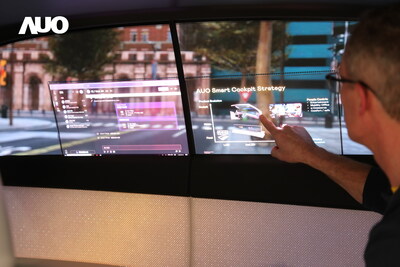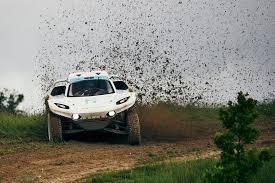
Scope of autonomous vehicle navigation
There are three ways a car may be navigated: totally in autonomous mode – without any driver intervention, semi-autonomously with some driver intervention, and completely driver controlled. A vehicle may be guided autonomously by the Global Positioning System (GPS), cameras, laser detectors, radar, wires in or lines on the road, or by transponders strategically located along a route. While road sensors or wires provide a more accurate navigation there are practical limits to installing them, given the number of roads involved. Navigational software includes pre-programmed routes, driving rules (such as stopping for red lights and lane changes), and user interfaces. Mechanical control is done by servo motors, relays, sensors, automated steering and braking, throttle management, and so forth.
With the improvement of automotive systems aided by computers and artificial intelligence, it should not be surprising to see the emergence of vehicles that drive themselves. Various names have been given to autonomously driven vehicles: uninhabited autonomous vehicle (UAV), autopilot vehicle, driverless car, auto-drive car, or automated/autonomously guided vehicle (AGV). An autonomously-driven vehicle is a true automobile, i.e., mobile on its own – self-propelled and navigated. A semi-autonomous vehicle can use any navigational method, but the driver intervenes to determine the routing and otherwise control the car. A person in a completely driver-controlled vehicle most often uses a map interfacing with GPS or a hand held device, such as a personal digital assistant (PDA) that displays locations via GPS. Routes ultimately are determined by the driver and may be charted by means such as on-board maps, web interface, or PDAs. Assisted navigation already is a reality. Smart cars have the capability of detecting empty parking spaces, thus obviating having to drive a long time searching. Already, in many cities there are timed traffic lights, where by maintaining an optimal speed, a driver can “make” every light without stopping. With forward-looking traffic control (automatic positioning), a driver is warned via a human-machine interface (HMI) of accidents, congestion, and construction, and is given the choice of different routes. A final step is intelligent and automated street or highway systems, where cars are integrated into an overall system and coordinated to result in a smooth and optimal traffic flow. High Occupancy Vehicle (HOV) lanes are precursors to this.
Feasibility of autonomously-driven vehicles
Pilotless vehicles are not new. Hydrogen balloons were guided by spark transmitters towards the end of the 19th century, and the British flew a monoplane called the Larynx [1] in the 1920s. During World War Two, radio controlled planes came more into vogue. Today we see remotely operated tractors tilling and seeding fields using the GPS, or even a cell phone.
We have remotely monitored and controlled systems such as OnStar for Chevrolet cars and Qualcomm for semi-trucks. Mostly everyone has heard of the Predator drones used by the U.S. military as “state-of-the-art”, although there are numerous problems of errors in targeting [3]. Especially since 1977, when Tsukuba Mechanical engineering lab built the first self-driving vehicle, development and sophistication has continued for autonomous ground vehicles. Another example of autonomous vehicle development was Carsense a project sponsored from 2000-20002 by the European Commission consisting of twelve European car manufacturing companies to illustrate the efficacy of autonomous vehicles. Long and short radar, cameras, and various sensors were used to pilot the vehicle.
The Defense Advanced Projects Research Agency (DARPA) of the U.S. Department of Defense (DoD), sponsored three DARPA challenges to build autonomously driven vehicles in March 2004, October 2005, and November 2007. The 2004 and 2005 ones involved vehicles running overland in off-road desert environments up to 240 km and up to 80 km per hour. In the first, only five vehicles traveled more than a couple of kilometers. Three vehicles completed more than 212 km in the second. The third challenge was in an urban environment and six vehicles traveled 60 miles.
From 26 July to 28 October 2010 four vehicles drove themselves 15,000 km from Parma Italy to Shanghai, China [4]. In the same year Google had seven driven for a total of 140,000 miles between Los Angeles and San Francisco with humans intervening only occasionally [5]. Routes were reprogrammed, along with essential data like speed limits. Google has gone so far as to ask Nevada to allow autonomous vehicles and texting in them [6]. As late as the middle of June 2011 Nevada approved the use of autonomous vehicles on its roads [7].
Stanford University, one of the winners of the U.S. Defense Research Projects Agency (DARPA) urban challenge in 2007, is carrying forth research on LIght Detection And Ranging, or Laser Imaging Detection and Ranging (LIDER) to create maps of a car’s environment and use that to navigate. Maps with locations of people and objects are continuously generated from this with centimeter accuracy and the data are used to determine an actual path.
Sequence of events in a typical UAV trip
A typical trip in an autonomous vehicle would be similar to the following. A driver has selected a destination, turns the ignition key to start the motor, and inputs the location into a computer in the car. If the car is connected to a network in a highly congested area, route selection might be determined by that network, the driver, at this point being a mere passenger. Otherwise the driver will have more independence in overriding the vehicle’s computer system. A power on self test (POST) is done by the computer, with sensors, instruments, and circuitry being tested for integrity. At such point, the computer activates the controllers of the power train, steering, and braking. Physical turning is done by servo motors which receive signals from the computer, which, in turn has received signals from the sensors. The vehicle backs or pulls out of its parking spot and the trip begins. Sensors in conjunction with navigation by GPS and maps generated by satellite in real time enable the car to maintain a correct trajectory. Over the years, computer assisted braking, steering, engine control, and navigation have been evolved to a point where all of these are being integrated into the autonomous vehicle. These systems now work in conjunction with each other – at least in theory – to provide a safe and economical trip.
Assessing the desirability of autonomously-driven vehicles
It is said trivially that “necessity is the mother of invention”, so it is not out of place to ask the question whether there should be autonomously-driven vehicles. Some major reasons in favor of such technology are:
 Coordinated vehicle control may be used to manage traffic congestion. It is worthy to note that Bill Ford, executive chairman of Ford Motor Company speech at Technology, Entertainment, Design (TED) conference in March 2011 stated we need “smart’ cars, “smart” roads, public transport, and other measures that will address the overcrowding of cars on the highways in order to have the freedom of mobility. He cited a 100 mile traffic jam in China during the summer of 2010 that took 11 days to clear. With most people living in cities world wide in the near future, people will not have the freedom to drive just anywhere they want at any time. High Occupancy Vehicle (HOV) lanes are a partial response to this, but certainly not sufficient. It will be problematical at best whether drivers will have as much control as they do now about routing, and driving very well may be determined by traffic flow. [9]
 A carefully controlled vehicle is safer, as it navigates more precisely and is not fraught with the human errors that are sources of transit problems, such as accidents, poor route selection, and inefficient driving practices. A major cause of accidents is tailgating and failing to keep distance, but cars that are autonomously driven are more accurate as they have not only precise navigation and monitoring equipment but devices exist to physically slow down or stop the car before it crashes [10].
 Autonomous vehicles are more fuel efficient, as fuel use and route selection result from careful computations, rather than from the rough estimates by a driver [11]. In addition, we may not have much choice about fuel use, given the mounting problem of Peak Oil [12]. Peak Oil will not only force the deployment of transportation using non-petroleum -based fuel, but there will have to be a more efficient flow and regulation of traffic to maximize fuel efficiency, and that can come about by the precision of autonomous vehicles.
 Autonomous navigation is more convenient in eliminating the “work aspect” of driving. A would be driver can become a passenger freed of the worry of the consequences of inefficient or generally poor driving.
 Very aged citizens, highly medicated, intoxicated, and blind people may be able to drive.
 There are disadvantages to autonomous vehicles, some being:
 There is less choice of routing and general control over the vehicle.
 Even if the option exists of switching from autonomous driving to driving by a person, the problem arises of integrating the switchover from a planned route to one that is determined by the driver and may not be compatible.
 There is the failure of systems and the consequences. One small disruption in a very large and integrated system may have disastrous effects.
 There is a continued dependence upon individual vehicles in face of looming constraints of diminishing fuel supplies and congestion. A false security arises in thinking that the increased efficiency and safety of autonomous systems is sufficient in overcoming these problems.
 The issue of hacking the software running autopilot looms. No further comment should be necessary here.
Want to learn more about current technologies and developments automotive navigation?
Visit our Download Centre for more articles, white papers and interviews:
http://bit.ly/automotive-navigation
References (Subject is indicated by URL – accessed 31 July 2011)
[1] http://en.wikipedia.org/wiki/Radio-controlled_aircraft#History
[2] http://www.youtube.com/watch?v=XAFw0L-E4hc&NR=1
[3] http://thebureauinvestigates.com/2011/07/18/washingtons-untrue-claims-no-civilian-deaths-in-pakistan-drone-strikes/
[4] http://en.wikipedia.org/wiki/VisLab_Intercontinental_Autonomous_Challenge
[5] http://www.nytimes.com/2010/10/10/science/10google.html
[6] http://www.nytimes.com/2011/05/11/science/11drive.html
[7] http://techie-buzz.com/tech-news/google-approval-self-driving-cars-nevada.html
[8] http://people.csail.mit.edu/kolter/lib/exe/fetch.php?media=pubs:levinson-iv2011.pdf
[9] http://www.ted.com/talks/lang/eng/robin_chase_on_zipcar_and_her_next_big_idea.html
[10] https://docs.google.com/viewer?url=http://www.wpi.edu/Pubs/E-project/Available/E-project-043007-205701/unrestricted/IQPOVP06B1.pdf&embedded=true&chrome=true
[11] https://docs.google.com/viewer?url=http://www.wpi.edu/Pubs/E-project/Available/E-project-043007-205701/unrestricted/IQPOVP06B1.pdf&embedded=true&chrome=true
[12] http://www.theoildrum.com/
Resources (Subject is indicated by URL – accessed 31 July 2011)
http://e2af.com/trend/080212.shtml
http://wn.com/automobile_navigation_system – compares different types
Autonomous Cars and Society – https://docs.google.com/viewer?url=http://www.wpi.edu/Pubs/E-project/Available/E-project-043007-205701/unrestricted/IQPOVP06B1.pdf&embedded=true&chrome=true
http://www.intempora.com/en/projects/automotive/adas/carsense
http://en.wikipedia.org/wiki/Controller_area_network
http://www.transport-research.info/web/projects/project_details.cfm?id=15260&page=outline
Stanford robot car “Junior” in action, DARPA Urban Challenge
http://www.youtube.com/watch?v=BSS0MZvoltw
http://www2.ece.ohio-state.edu/citr/Demo97/osu-av.html
Transponder use – http://www.mikechiafulio.com/RIDE/system.html
Path selection method – http://ftp.utcluj.ro/pub/docs/imaging/Autonomous_driving/Articole%20sortate/TUBraunschweig/iv980304.pdf
http://www.intempora.com/en/projects/automotive/adas/carsense
Excellent history summary of UAVs – http://faculty.washington.edu/jbs/itrans/bishopahs.htm
http://www.ivsource.net/archivep/2000/jul/a000731_carsense.html














More Stories
The Dangers of Interstate Truck Pileups and What They Mean for Victims
5 Conclusions One Can Make by Analyzing Car Accident Statistics
Why You Should Invest in Regular Car Washes to Protect Your Investment